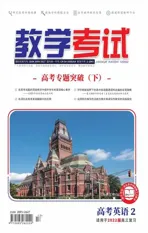高考听力之推理判断题型能力提升探究
2022-07-22浙江
浙江 南 红
高考听力的推理判断题是高考英语的必考题,考查数量较多,是决胜听力的关键。听此类材料时,考生要在听懂事实细节的同时,对信息进行简单的加工,作出合理的推断。这类题目的听力材料内容组织巧妙,材料的重要信息有些“隐蔽”,选项干扰性强,难度稍大,试题做起来不容易。教师总结归纳此类题型的规律,给予学生相应的应对策略,有利于提升其听力训练的效果,帮助其增强自信,使其面对推理判断题型时更加得心应手,从而在高考中占得优势。
一、听力之推理判断题型的应对策略
1.熟悉题干,精准定位
推理判断题型是听力中比较复杂的题型,学生在听录音的过程中,要注意捕捉关键词,理解说话人的言外之意,还要注意说话人的语调,降调表示赞同、肯定,升调表示怀疑、惊讶或否定。同时学生要熟悉此类题型的题干特点,题干通常有:
①What can we say about the woman?(2018年全国卷Ⅰ,2)
②Where does the conversation probably take place?(2019年全国卷Ⅱ,1)
③What is Mark’s attitude towards Cathy’s decision?(2020年全国卷Ⅰ,9)
④Who might be able to help Tom this week?(2020年7月浙江卷,7)
⑤What does the woman seem to suggest Bill do?(2020年7月浙江卷,13)
⑥How does the man feel now?(2021年1月浙江卷,5)
⑦Why should you listen to experts according to the speaker?(2021年新高考Ⅰ卷,19)
⑧What is the man most likely to have for dinner?(2021年1月浙江卷,7)
⑨What is the probable relationship between the speakers?(2021年1月浙江卷,6)
⑩ What do most people think is very important in spoken communication?(2021年6月浙江卷,18)
由于此类题型的材料内容有些绕弯,因此熟悉此类题型的题干,是精准定位并作出推理判断的前提,在此基础上才能正确解题。学生在平时的听力训练中,要养成快速定位的习惯,可以将Who(人物),What(事件),When(时间),Where(地点),Why(原因),How(方式),How long/How soon/How often/How many/How much(程度),Which(选择)和谓语动词加下划线,提醒自己听力时将注意力集中在对整体内容的理解上,不要强求听懂每一个词,集中精力关注与标有下划线的内容相关的重要信息,边听边把材料要点和关键词记下来,这样学生在做题时才能有的放矢,有理有据,精准推理,正确判断。
2.精通类型,抓准信息词
迅速明确推理判断的类型,能给学生足够的预判信心。听力的推理判断题主要有以下几种类型,每种类型都有相应的信息词,抓住信息词就能明确关系。
(1)对人物关系的判断
常见的人物关系有husband-wife,teacher-student,classmates,colleagues,doctor-patient,waiter-customer等。在熟悉了常见的人物关系类型后,学生还要了解相关关系的信息词,比如:同学关系的信息词有course,assignment,term,paper,exam,final,grade,quiz,professor,vacation等;顾客与服务员关系的信息词有menu,order,dessert,delicious,taste,bill等;同事关系的信息词有company,boss,department,office,document等;医生与病人关系的信息词有headache,pill,catch a cold,fever,temperature,medicine,treatment,recover,operation等。学生在听录音时要积极捕捉称谓名词、职业名词及与活动地点和活动内容相关的词,这些词都含有指向信息,如:
【例1】(2019年全国卷Ⅱ,7)What is the probable relationship between the speakers?
A.Husband and wife.
B.Employer and employee.
C.Shop assistant and customer.
W:I’m going out for shopping.Do you need anything?
M:Oh,yeah,I can’t find my umbrella.Can you buy one?
W:Shouldn’t it be in the cupboard?
M:I just checked.It wasn’t there.
W:Impossible.That was where I usually put it.Did you check the balcony?
M:Yes,of course.Couldn’t find it.Well,just get a new one then.
通过抓住关键信息“Shouldn’t it be in the cupboard?”和“That was where I usually put it.Did you check the balcony?”可以判断出对话双方是夫妻关系。
【例2】(2021年1月浙江卷,6)What is the probable relationship between the speakers?
A.Husband and wife.
B.Hostess and guest.
C.Chef and customer.
M:I’m starving.What arewehaving for dinner tonight,Jane?
...
W:Actually,I was thinking of making something healthy,say...fish and vegetables.
M:Well,in that case,I’ll have whatever you make.
通过抓住对话用语“I’m starving.”和“say”,可见对话双方关系比较亲密,再加上“we”的使用,可以判断出对方双方是夫妻关系。
【例3】(2018年全国卷Ⅰ,5)What is the probable relationship between the speakers?
A.Classmates.
B.Teacher and student.
C.Doctor and patient.
W:Hi,Andy.I didn’t see you inProfessorSmith’sclassyesterday.What happened?
M:Well,I had a headache.So,I called him and asked forsick leave.
通过抓住称谓名词“Professor”,活动内容“class”和“sick leave”可以判断出对话双方是师生关系。
(2)对谈话场景、地点的判断
所考场景词若未曾出现在音频中,学生要靠活动内容的指向来判断。多个线索所指向的共同点则是答案。捕获记录到最关键的线索是成功解题的关键。例如:

同时学生要熟悉提问的方式,比如:Where does this conversation probably take place? Where did it happen? Where is...? Where will she go? Where did she go?关注题干中的when,who和where,听录音时捕捉相关的信息,依据合理的指向信息作出正确的判断,如:(2019年全国卷Ⅰ,1)Where does this conversation take place?
A.In a classroom. B.In a hospital. C.In a museum.
W:Excuse me,Sir.Visiting hoursare over now.Your wife must get some rest.
M:Oh,I’m sorry,doctor.I didn’t hear the bell,or I would’ve left earlier.
学生在听这个对话时只要抓住了时间“Visiting hours”和人物“doctor”,就能判断出对话是在医院发生的。
(3)对谈话人行为状态的推测
暗示重点的信息词一般都是承接上下文的词汇,如and,so,but,as a result,however,or,otherwise,while,since,finally,next,in conclusion。通过这些信息词可以看出说话人的思路,这些信息词表示时间、空间、举例、比较、分析和总结等逻辑关系。具体可以分为以下几类:
①表示转折的词有:but,although,though,yet,even though等;
②表示时间顺序的词有:first,second,third,next,after that,then,last,finally等;
③表示强调的词有:indeed,anyway,in fact,as a matter of fact等;
④表示原因和结果的词有:because,as,for,since,so,as a result等;
学生可以关注这些信息词,明确意义指向,作出精准判断,如:
【例1】(2017年全国卷Ⅱ,1)What will the woman do this afternoon?
A.Do some exercise.
B.Go shopping.
C.Wash her clothes.
M:Let’s go for a nice walk into the country this afternoon.
W:I certainly could enjoy the exercise,butI’ve agreed to go with Alice to buy some clothes.
通过转折信息词“but”可以看出说话人的意图在“but”之后,很明显女人是要去购物。
【例2】(2020年7月 浙 江 卷,20)What will the speaker do next?
A.Ask a few questions.
B.Show some notes.
C.Make a summary.
W:Today,let’s begin with note-taking techniques.Note-taking is an important skill not only for taking classes,but also for doing your job in the future.I’d like to draw your attention to certain points about taking notes.First,remember that note-taking should be 75% listening and only 25% writing,so don’t try to write down every single word the teacher says.Ignore what is unimportant and write in phrases,not complete sentences.Second,leave spaces and lines between main ideas.You may want to add some information later.I find that some of you are very good at making use of color,mapping web,and symbols such as arrows,circles and boxes.I highly recommend these tools to all of you,because the use of them makes the outline more easily readable and interesting than the blocks of text.It also makes sure that important words stand out.Here are some examples.
虽然有“Here are some examples.”这样比较明显的提示,但如果学生关注这篇讲话稿最后几句话里的逻辑关系信息词“because”和“also”的使用,就可以更加明确地看出,因果关系和并列关系的使用是在说明使用这些工具的好处,为“Here are some examples.”做好铺垫,因此接下来要展示作品了。
(4)对数字的推理判断
学生要培养瞬间记忆的能力,边听边记,用自己认识的符号来标记,保留听力过程,如:
【例1】(2019年全国卷Ⅱ,3)How much will the man pay?
A.$20.
B.$80.
C.$100.
M:How much is that in total?
W:100 dollars.But if you have a membership card,I can give youa 20% discount.
M:Great! This is my membership card.
通过记录原始数字100,然后再根据“打八折”,计算出最后结果为80美元。
【例2】(2020年7月浙江卷,16)How much time does the man have to read the book?
A.Two weeks.
B.Three weeks.
C.Four weeks.
...
W:I wanted to let you know about a book club I joined a few months ago.I know you do a lot of reading,so I thought you might want to come with me next month.
M:Oh,that sounds like fun.When does the group meet?
W:Usually the last Saturday of the month at 7:30 in the evening.Is that too late for you?
M:No,I think that’s okay.What do you talk about in the group?
W:Well,every month we choose a new book.And then during the next meeting,we discuss it.
...
M:That sounds interesting.I’d love to come.
W:Great!The next meeting will be held in two weeks,so you still have time to read the book.
通过最后一句话“ The next meeting will be held in two weeks”可以推断,在下次会议举行之前,还有两周的时间来看书。
(5)对谈话者态度的判断
高考听力测试不但要求考生能听懂录音原文,还要能听出“弦外之音”。在对话中,说话者通常不直接说出自己的观点,而常以委婉甚至拐弯抹角的方式间接作答,这样就能较有效地测试考生捕捉有用信息,并运用所听信息进行推理判断的能力,如:
【例1】(2021年1月山东卷,7)How does the man sound?
A.Impatient.
B.Confused.
C.Humorous.
M:Come on.It’s time to go.We promised Mom not to be late.
W:Just hold your horses.What’s the hurry anyway?
M:Well,I’ve to get to stop and put gas in the car first.
W:That won’t take long.
M:Well,it won’t if there is no line there.
W:But I’m not quite ready.
M:I’ll give you five more minutes.Then I’m going on without you.
W:You wouldn’t do that to me.
M:Oh,yes,I would.
根据女士的话“Just hold your horses.”可知,女士让男士别着急,但是学生可能不清楚这个句子表达的意思,还要结合后面的“I’ll give you five more minutes.(我再给你五分钟)”去理解,其再次说明男士很着急,最后男士的回答“Oh,yes,I would.”,也说明男士真的很着急,因此可以判断出男士已经不耐烦了。
【例2】(2017年11月浙江卷,11)What does Maria think of the soup?
A.Tasteless.
B.Just fine.
C.Thick.
W:I’m not sure about this soup,Carl.It hasno taste.
M:No! I don’t think so,Maria.It tastes fine to me.We’ve been to this place before,and I don’t feel the soup tastes any different.
W:Well,I still think itneeds something.Salt?
M:No,certainly not.What aboutpepper? If anything,I think it could use a little more of that.
W:Now you are talking.That’s exactly what it needs.And how about some moreonionstoo?
M:I don’t know about that.You seem to be starting to like food withwrong tastesrecently.
W:Oh,really?
这个对话有些绕,最后也没有明确地说Maria口味变重了,但是实际的观点通过一些关键词体现出来了,如no taste,needs something,Salt,pepper,“Now,you are talking.”,onions,wrong tastes,虽然对话绕来绕去,态度好像不明确,但是学生可以推断出Maria的口味变重了,那么汤就是无味的。
二、听力之推理判断题型训练技巧
1.积累含蓄的英语表达方式
听力中对话者会采用比较含蓄的方式表达意图,学生需要了解语音、语调和重读等语音手段,否定、反问、比较、虚拟、转折等语法手段以及它们所表示的怀疑、肯定、否定、赞同、感叹等意思。如,2020年7月浙江卷第8段材料,“So you have to wait for about two hours? I don’t think there’s scenery to look at.”用了否定表示怀疑;2021年1月山东卷第6段材料,“You wouldn’t do that to me.Oh,yes,I would.”用了反问句表示肯定;2021年6月浙江卷第6段材料,“That way,they are less exciting,though.”用了比较表示否定;2020年7月浙江卷第2段材料,“If I were you,I’d just walk to work.It would take you about 20 minutes.”用了虚拟语气表示赞同;2021年6月浙江卷第6段材料,“That way,they are less exciting,though.”用了转折表示感叹。学生可以利用语音、语调、语法和常识等进行逻辑推理和判断,辨别说话人的意图、暗示、态度和要求等。
2.培养逆向或正向思维能力
学生要抓住听力内容里的关键信息,比如,一些表示时间、地点、人物关系和数据的信息,还要利用逆向或正向思维,推断出听力材料中所隐含的信息,这将有助于他们快速抓住听力材料的要点和中心思想,避免其掉入细节事实的陷阱,同时为得出正确答案提供必要依据。
3.增强对生活常识的运用
在日常生活中所积累的常识和经验,有助于学生在听力过程中确认答案,学生所拥有的生活常识和经验越丰富,对背景知识的整体把握就越到位,因此答对题目的概率就越高。
4.以读促听提升英语素养
扩大阅读量或经常收听(看)英语节目,丰富英美背景知识,熟悉英美习惯表达,提升英语的综合素养,试着用英语思考和解决问题,培养好的思维习惯,都有利于学生解决比较复杂的推理判断题。
总而言之,推理判断题是高考听力中的难点,教师需要有针对性地研究,对学生常错易错题型进行归纳和分析,并提出相应的训练方法,这是提高学生听力训练效率的必要举措。
